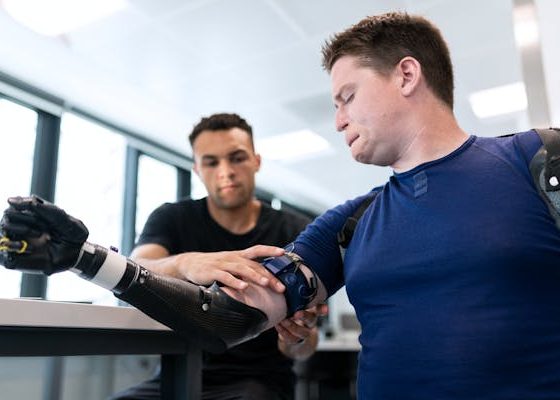
Augmented Reality (AR) has emerged as a groundbreaking technology, reshaping various industries. One of its most profound applications has been in the realm of education. By blending the real world with virtual elements, AR offers educators and students interactive and immersive experiences that were once unimaginable. The benefits of augmented reality in education are vast, touching upon multiple aspects of teaching, learning, and the development of new educational paradigms.
What is Augmented Reality (AR)?
Augmented Reality refers to the enhancement of the physical environment by overlaying digital information or images. Unlike Virtual Reality (VR), which immerses users in a completely virtual world, AR enhances what one already sees, often using a smartphone, tablet, or AR glasses. For example, AR might allow students to see historical figures come to life in their classroom or visualize complex chemical molecules hovering in front of them.
This capacity to merge the digital and physical worlds brings significant changes to the way we teach and learn, fostering a more engaging and dynamic educational experience.
How Augmented Reality Works in Education
Before delving into the benefits of augmented reality in education, it’s essential to understand how it functions in a classroom setting. Educational AR apps use cameras and sensors in mobile devices or AR glasses to identify specific triggers—like a QR code or an image in a textbook. Once the trigger is recognized, the AR system overlays digital content (such as 3D models, animations, or text) over the real-world image viewed through the device’s screen. This enhances the learning experience by creating interactive content that responds to the learner’s real environment.
For example, a biology student can scan a picture of a human heart and see a 3D model appear on their device. They can rotate the model, zoom in on various parts, and interact with labels or videos explaining the heart’s function.
The Benefits of Augmented Reality in Education
1. Enhanced Engagement and Motivation
One of the primary benefits of augmented reality in education is its ability to significantly increase student engagement. Traditional educational methods often struggle to capture the attention of today’s digital-native students. However, AR’s immersive nature offers an exciting alternative to traditional textbooks and lectures. When students can interact with 3D models or virtually experience historical events, they are more likely to remain interested and motivated.
Interactive AR experiences turn passive learning into active exploration. For example, geography students can use AR to explore topographical features of the Earth, while history students can witness reenactments of significant battles or cultural events. These experiences immerse students in learning in a way that traditional methods cannot match.
2. Improved Learning Retention
Learning retention refers to the ability of students to remember and recall information. Several studies have shown that interactive learning methods, such as those facilitated by AR, enhance retention rates. This is because AR stimulates multiple senses, allowing students to learn through visual, auditory, and kinesthetic engagement.
For instance, using AR to dissect a frog digitally allows students to perform an action (like dragging a scalpel), visualize the frog’s anatomy, and listen to explanations, all at once. This multi-sensory approach reinforces memory, making the learning experience more memorable and effective.
3. Facilitates Hands-On Learning
One of the benefits of augmented reality in education is that it allows students to engage in hands-on learning experiences without the limitations of physical materials or space. In fields such as science and engineering, experiments or simulations often require expensive equipment or laboratory space. AR can simulate these environments, providing students with a safe and cost-effective way to conduct experiments or practice skills.
For example, chemistry students can perform virtual lab experiments using AR, mixing chemicals and observing reactions without the risk of accidents. Similarly, medical students can practice complex surgical procedures in a virtual space, building their skills and confidence before handling real-life situations.
4. Personalized Learning Experiences
Personalization is a key factor in modern education, as students learn at different paces and have unique learning styles. AR allows educators to tailor the learning experience to meet individual student needs. Through AR, students can explore concepts at their own pace, receive real-time feedback, and dive deeper into topics that interest them.
For example, a student struggling with geometry might use an AR app that allows them to manipulate and explore 3D shapes until they fully grasp the concepts. Conversely, a student who excels in a particular subject can use AR to explore advanced topics, receiving customized challenges that push their understanding further.
5. Enhanced Visualization of Abstract Concepts
Many subjects in education, particularly in STEM fields, involve abstract concepts that are difficult for students to visualize. AR bridges this gap by transforming intangible ideas into tangible, interactive 3D objects. For example, AR can help students visualize complex mathematical equations, chemical structures, or the human body’s anatomy.
In physics, for instance, students often struggle to conceptualize abstract ideas like force fields or quantum particles. Through AR, these abstract phenomena can be brought to life in visual form, helping students understand them better.
6. Encourages Collaboration and Group Learning
Another significant benefit of augmented reality in education is its ability to foster collaboration. AR projects can be designed for group interactions, encouraging students to work together to solve problems, complete projects, or explore new concepts. Collaborative learning enhances critical thinking, problem-solving skills, and communication, all of which are essential for success in the modern workforce.
For example, in a history class, students might work together to explore an AR simulation of an ancient civilization, assigning roles such as archaeologists or architects to each group member. This promotes a deeper understanding of the subject while simultaneously developing teamwork skills.
7. Creates Immersive Learning Environments
One of the most exciting benefits of augmented reality in education is the creation of immersive learning environments. AR can transport students to different times, places, or even inside the human body. This ability to create a contextualized learning environment deepens students’ understanding of complex topics and makes learning more enjoyable.
For instance, a literature class studying Shakespeare could use AR to transport students to a virtual recreation of the Globe Theatre, allowing them to experience the plays as Elizabethan audiences did. Similarly, a biology class could take a virtual journey through the circulatory system, witnessing blood cells in action.
8. Real-World Application and Skills Development
Augmented Reality also provides opportunities for students to apply their learning to real-world situations. Whether it’s learning how to perform technical tasks, such as car repair or medical procedures, or practicing soft skills like communication and teamwork, AR offers realistic simulations that mirror real-world experiences.
For example, vocational students learning automotive repair can use AR to overlay digital instructions on real car parts, showing them how to dismantle and reassemble the engine without the risk of damaging the vehicle. Similarly, students in healthcare fields can practice interacting with patients in simulated scenarios, helping them develop essential communication and diagnostic skills.
9. Accessibility and Inclusivity
AR can help create a more inclusive learning environment by providing alternative ways to access educational content. Students with different learning abilities or disabilities can benefit from AR’s visual and interactive elements. For example, hearing-impaired students can use AR to visualize spoken content, while visually impaired students might benefit from auditory descriptions and haptic feedback in AR simulations.
AR can also help students who struggle with traditional text-based learning by offering alternative modes of engagement. Whether through visual models, interactive simulations, or gamified lessons, AR provides multiple pathways to understanding.
10. Cost-Effective and Scalable Learning Solutions
While the initial investment in AR technologies might seem high, its long-term benefits can result in cost savings for educational institutions. By replacing expensive physical materials and allowing students to practice and experiment in virtual environments, AR can reduce costs associated with laboratory supplies, field trips, and printed textbooks.
Moreover, AR solutions are highly scalable, allowing institutions to deploy them across large numbers of students and subjects with ease. Once an AR platform is developed, it can be updated and adapted without requiring significant ongoing costs.
11. Bridging the Gap Between Theory and Practice
In many fields, there is often a disconnect between theoretical knowledge and practical application. AR helps bridge this gap by allowing students to apply theoretical concepts in simulated real-world situations. This is especially beneficial in fields like engineering, healthcare, and vocational training, where practical experience is essential.
For instance, engineering students can use AR to design and test virtual models of buildings or machinery, applying their theoretical knowledge in a practical context. Medical students, meanwhile, can use AR to practice diagnosing and treating patients in a risk-free virtual environment, gaining valuable hands-on experience.
12. Augmented Reality in Distance and Remote Learning
The rise of online and distance learning has necessitated new ways of engaging students who are not physically present in the classroom. AR has the potential to revolutionize distance education by creating interactive and immersive learning experiences that students can access from anywhere.
With AR, distance learners can participate in virtual labs, field trips, or interactive simulations without ever leaving their homes. This ensures that students receive the same quality of education, regardless of their location. AR also helps remote learners feel more connected to their peers and instructors by creating shared virtual experiences.
13. Gamification and Interactive Learning
Gamification is the incorporation of game-like elements into non-game contexts, such as education. AR enhances gamification by creating interactive learning experiences that feel like playing a game. This increases student engagement and motivation, particularly for younger learners.
For example, AR can turn a history lesson into an interactive quest where students explore ancient ruins, solve puzzles, and interact with historical figures. Similarly, a science class could become an exploration of the human body, with students earning points for correctly identifying organs and systems.
14. Real-Time Feedback and Assessment
One of the major benefits of augmented reality in education is the ability to provide real-time feedback and assessment. AR apps can track student progress, offer hints or corrections, and assess their understanding of the material as they engage with it.
For instance, a math app might highlight errors in a student’s calculations as they work through a problem, allowing them to correct mistakes immediately. This instant feedback helps reinforce learning and ensures that students do not continue practicing incorrect methods.
15. Fosters Creativity and Innovation
AR encourages students to think outside the box and explore new ways of approaching problems. By providing an interactive and dynamic learning environment, AR fosters creativity and innovation in students, encouraging them to experiment with new ideas and explore different perspectives.
For example, art students can use AR to create digital sculptures or paintings that blend real-world objects with virtual elements. In science and engineering, AR allows students to design and test prototypes in a virtual space, fostering innovation and creativity in their problem-solving approaches.
Conclusion
The benefits of augmented reality in education are vast and transformative. AR has the potential to revolutionize traditional learning environments, making education more engaging, interactive, and personalized. It enhances student engagement, improves retention, and helps visualize complex concepts. Additionally, it supports collaboration, accessibility, and real-world skills development.
As AR technology continues to evolve, its role in education will undoubtedly expand, offering even more innovative ways to teach and learn. By embracing AR, educators can create immersive and interactive learning experiences that prepare students for the challenges and opportunities of the 21st century.


